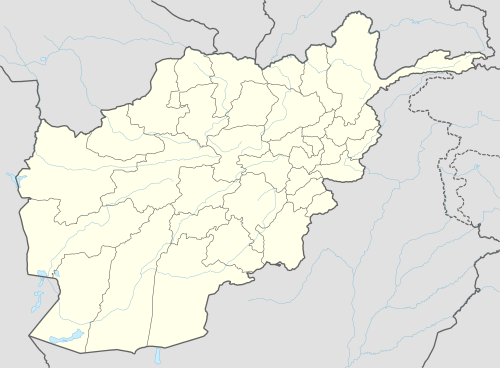Shibar District
| Shibar شیبر | |
|---|---|
| District | |
 Shibar Location within Afghanistan[1] | |
| Coordinates: 34°55′12″N 68°02′24″E / 34.92000°N 68.04000°E | |
| Country |
|
| Province | Bamyan Province |
| Elevation | 2,637 m (8,652 ft) |
| Population (2011) | |
| • Total | 25,532 |
Shibar District (pop.: 25,532 in the year 2011)[2] is located in the western end of the Bamyan Province in Afghanistan. It is in a mountainous region. The main village Shibar is at 2,637 m altitude on the all-seasons secondary road from Bamyan to Kabul through the Shibar pass.
The northern portion of the district, beginning near the village of Ghandak, is Tajik. Several Tajik villages can also be found along the road to the Hajigak Pass from Tupchi to Colo. Following the collapse of the Taliban, these villages faced harassment from a Hazara warlord nicknamed "Black Hat" who was based in the Tupchi area and occupied a check point and a ruined fortified city (the Red City) that had been destroyed by Genghis Khan. The balance of the population outside these Tajik villages is Hazara, however those Hazara villages on the east side of the Shibar pass are mostly Sunni. There are 200 families living here. Most of the youth are unemployed.[3]
Development
On August 2009 The asphalting of a 110-km road linking Jabal-us-Siraj district of central Parwan province to Shibar Pass began, the road would be constructed in one year at the cost of $60 million provided by the US PRT.
Health and security
The district Health care is poor due to a lack of Health Care centers and poor transport. In July 2009, Agha Khan Development Network (AKDN) provided $4.9 million in Shibar district during the next 12 years to improve health services in the area.
The New Zealand PRT, operate in the district as well as most of Bamyan Province.
Hajigak Mine
The hajigak iron ore was discovered at Hajigak mining concession near Hajigak Pass in 1960; it is mainly located in this district, however the mine is also found across the Hindu Kush Mountains between Bamyan and Maidan Wardak provinces, the mine is 550 meters in depth. On October 2011 several checkpoints were established and 1,700 security personal were deployed, leading to an improvement in security around the Hajigak iron-ore mine.
Indian govt plans
In May 2016, India, Iran and Afghanistan signed an agreement to develop two births at Port of Chabahar, build new Chabahar-Zahedan railway as part of North–South Transport Corridor by linking it with Trans-Iranian Railway, invest up to INR 1 lakh crore (US$14 billion) in the Chabahar Special Economic zone by building gas and urea plant as well as other industries, this will also be linked with Chabahar-Zaranj-Delaram-Hajigak railway: 900 km long Indian-Iranian project, would link future US$10 billion Indian iron-ore mining operations at Hajigak, Afghanistan to Chabahar, Iran, Published: Feb 2015.[4]
See also
- Hindu Kush Mountains
- Tadjikistan
- The Silk Road
- Bamyan District
References
- ↑ "District Names". National Democratic Institute. Retrieved 19 August 2015.
- ↑ "Bamiyan Socio-Demographic and Economic Survey" (PDF). Central Statistics Organization. Retrieved 19 August 2015.
- ↑ "Donkeys replace ambulances in sticks". quqnoos.com. 10 April 2008. Retrieved 6 July 2010.
- ↑ India-Iran sign key agreements, Published: 23 May 2016